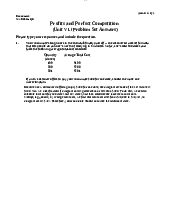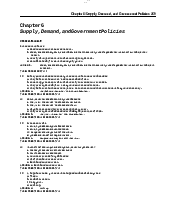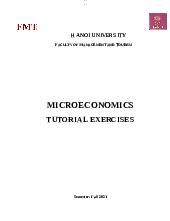



















Preview text:
lOMoARcPSD|46342985
Chapter 14/Firms in Competitive Markets 405 Chapter14
FirmsinCompetitiveMarkets MULTIPLECHOICE A marketiscompetitiveif 0
firmshavetheflexibilitytopricetheirownproduct.
5888eachbuyerissmalcomparedtothemarket.
(i)eachselerissmalcomparedtothemarket. a.(i)and(i)only b.(i)and(i)only 23 (i)and(i)only d.Aloftheabovearecorrect. ANSWER:c. (i)and(i)only TYPE:MDIFFICULTY:2SECTION:14.1
5888 Whenafirm haslittleabilitytoinfluencemarketpricesitissaidtobeinwhatkindofamarket? a.acompetitivemarket b.astrategicmarket c.athinmarket d.apowermarket ANSWER:a. acompetitivemarket TYPE:MDIFFICULTY:1SECTION:14.1 23
Inacompetitivemarket,theactionsofanysinglebuyerorselerwil
a.haveaneglgibleimpactonthemarketprice.
b.havelittlee ectonoveralproductionbutwilultimatelychangefinalproductprice. ff
c.causeanoticeablechangeinoveralproductionandachangeinfinalproductprice.
d.adverselya ectheprofitabilityofmorethanonefirm inthemarket. ff ANSWER:a.
haveaneglgibleimpactonthemarketprice. TYPE:MDIFFICULTY:2SECTION:14.1
Usetheinformationinthetablebelow toanswerquestions4through7. Quantity Price 5888 13 23 13 5888 13 23 13 23 13 23 13 23 13 23 13 13 23
Thepriceandquantityrelationshipinthetableismostlikelythatfacedbyafirm ina a.monopoly. b.concentratedmarket. c.competitivemarket. d.strategicmarket. ANSWER:c. competitivemarket. TYPE:MDIFFICULTY:1SECTION:14.1 23
Overwhichrangeofoutputisaveragerevenueequaltoprice? a.1to5 b.3to7 c.5to9
d.Averagerevenueisequaltopriceoverthewholerangeofoutput.
ANSWER:d. Averagerevenueisequaltopriceoverthewholerangeofoutput. TYPE:MDIFFICULTY:1SECTION:14.1 lOMoARcPSD|46342985
Chapter 14/Firms in Competitive Markets 406 23
Overwhatrangeofoutputismarginalrevenuedeclning? a.1to6 b.3to7 c.7to9
d.None;marginalrevenueisconstantoverthewholerangeofoutput.
ANSWER:d. None;marginalrevenueisconstantoverthewholerangeofoutput. TYPE:MDIFFICULTY:2SECTION:14.1 23
Ifthefirm doublesitsoutputfrom 3to6units,otalrevenuewil
a.increasebylessthan$39. b.increasebyexactly$39. 23 increasebymorethan$39.
d.Itcannotbedeterminedfrom theinformationprovided. ANSWER:b. increasebyexactly$39. TYPE:MDIFFICULTY:1SECTION:14.1 23
Forafirm inaperfectlycompetitivemarket,thepriceofthegoodisalways a.equaltomarginalrevenue. b.equaltootalrevenue. 23 greaterthanaveragerevenue. d.Aloftheabovearecorrect. ANSWER:a. equaltomarginalrevenue. TYPE:MDIFFICULTY:1SECTION:14.1 23
Ifafirm inaperfectlycompetitivemarketriplesthenumberofunitsofoutputsold,thenotalrevenuewil a.morethantriple. b.lessthantriple. 23 exactlytriple.
d.Aloftheabovearepotentialytrue. ANSWER:c. exactlytriple. TYPE:MDIFFICULTY:1SECTION:14.1 23
Becausethegoodso eredforsaleinacompetitivemarketarelargelythesame, ff
a.therewilbefew selersinthemarket. b.therewilbefew buyersinthemarket. c.buyerswilhavemarketpower.
d.selerswilhavelittlereasontochargelessthanthegoingmarketprice.
ANSWER:d. selerswilhavelittlereasontochargelessthanthegoingmarketprice. TYPE:MDIFFICULTY:1SECTION:14.1
11. WhichofthefolowingisNOTacharacteristicofaperfectlycompetitivemarket? a.Firmsarepricetakers.
b.Firmshavedi cultyenteringthemarket. ffi
23 Therearemanyselersinthemarket.
d.Goodso eredforsalearelargelythesame. ff ANSWER:b.
Firmshavedi cultyenteringthemarket. ffi TYPE:MDIFFICULTY:1SECTION:14.1 23
Whenbuyersinacompetitivemarketaketheselingpriceasgiven,theyaresaidtobe a.marketentrants. b.monopolists. 23 freeriders. d.pricetakers. ANSWER:d. pricetakers. TYPE:MDIFFICULTY:1SECTION:14.1
13. Whenfirmsaresaidtobepricetakers,itimpliesthatifafirm raisesitsprice, a.buyerswilgoelsewhere.
b.buyerswilpaythehigherpriceintheshortrun.
23 competitorswilalsoraisetheirprices.
d.firmsintheindustrywilexercisemarketpower. ANSWER:a. buyerswilgoelsewhere. TYPE:MDIFFICULTY:1SECTION:14.1 lOMoARcPSD|46342985
Chapter 14/Firms in Competitive Markets 407 0
Whichofthefolowingstatementsbestreflectsaprice-takingfirm?
a.Ifthefirm weretochargemorethanthegoingprice,itwouldselnoneofitsgoods.
b.Thefirm hasnoincentivetochargelessthanthegoingprice.
c.Thefirm canselasmuchasitwantstoselatthegoingprice. d.Aloftheabovearecorrect. ANSWER:d. Aloftheabovearecorrect. TYPE:MDIFFICULTY:2SECTION:14.1
Inacompetitivemarket,nosingleproducercaninfluencethemarketpricebecause
a.manyotherselersareo eringaproducthatisessentialyidentical. ff
b.consumershavemoreinfluenceoverthemarketpricethanproducersdo.
0 governmentinterventionpreventsfirmsfrom
influencingprice. d.producersagreenottochangetheprice. ANSWER:a.
manyotherselersareo eringaproducthatisessentialyidentical. ff TYPE:MDIFFICULTY:2SECTION:14.1
16. A competitivefirm mightchoosetosetitspricebelow
themarketprice,because a.thiswouldresultinhigheraveragerevenue.
b.thiswouldresultinhigherprofits. 0
thiswouldresultinlowertotalcosts. d.Noneoftheabovearecorrect. ANSWER:d. Noneoftheabovearecorrect. TYPE:MDIFFICULTY:2SECTION:14.1 0
Ofthefolowingcharacteristicsofcompetitivemarkets,whicharenecessaryforfirmstobepricetakers? Therearemanyselers. 0
Firmscanfreelyenterorexitthemarket.
(i)Goodso eredforsalearelargelythesame. ff a.(i)and(i)only b.(i)and(i)only c.(i)only d.Alarenecessary. ANSWER:b. (i)and(i)only TYPE:MDIFFICULTY:2SECTION:14.1 0
Whenafirm inacompetitivemarketproduces10unitsofoutput,ithasamarginalrevenueof$8.00.Whatwouldbe
thefirm’stotalrevenuewhenitproduces6unitsofoutput? a.$4.80 b.$6.00 0 $48.00 d.$60.00 ANSWER:c. $48.00 TYPE:MDIFFICULTY:2SECTION:14.1 0
Whenafirm inacompetitivemarketreceives$500inotalrevenue,ithasamarginalrevenueof$10.Whatisthe
averagerevenue,andhow manyunitsweresold? a.$5and100 b.$10and50 c.$10and100
d.Theanswercannotbedeterminedfrom theinformationgiven. ANSWER:b. $10and50 TYPE:MDIFFICULTY:2SECTION:14.1 0
Startingfrom asituationinwhichafirm inacompetitivemarketproducesandsels500doorknobsforapriceof$10
perdoorknob,whichofthefolowingeventswoulddecreasethefirm’saveragerevenue?
a.Thefirm increasesitsoutputabove500doorknobs.
b.Thefirm decreasesitsoutputbelow 500doorknobs.
23 Themarketpriceofdoorknobsrisesabove$10.
d.Themarketpriceofdoorknobsfalsbelow $10. ANSWER:d.
Themarketpriceofdoorknobsfalsbelow $10. TYPE:MDIFFICULTY:1SECTION:14.2 lOMoARcPSD|46342985
Chapter 14/Firms in Competitive Markets 408 23
Wheneveraperfectlycompetitivefirm
choosestochangeitslevelofoutput,holdingthepriceoftheproduct constant,itsmarginalrevenue a.increasesifMRATC. b.doesnotchange. c.increases. d.decreases. ANSWER:b. doesnotchange. TYPE:MDIFFICULTY:1SECTION:14.1 23
Ifafirm inacompetitivemarketreducesitsoutputby20percent,thenasaresultthepriceofitsoutputislikelyto a.increase. b.remainunchanged.
23 decreasebylessthan20percent. d.decreasebymorethan20percent. ANSWER:b. remainunchanged. TYPE:MDIFFICULTY:1SECTION:14.1 23
Changesintheoutputofaperfectlycompetitivefirm,wihoutanychangeinthepriceoftheproduct,wilchangethe firm’s a.otalrevenue. b.marginalrevenue. 23 averagerevenue. d.Aloftheabovearecorrect. ANSWER:a. otalrevenue. TYPE:MDIFFICULTY:2SECTION:14.1 23
Whenaprofit-maximizingfirm inacompetitivemarkethaszeroeconomicprofit,accountingprofit
a.isnegative(accountinglosses). b.ispositive. c.isalsozero.
d.couldbepositive,negativeorzero. ANSWER:b. ispositive. TYPE:MDIFFICULTY:2SECTION:14.1
25. Asageneralrule,whenaccountantscalculateprofittheyaccountforexplicitcostsbutusualyignore
a.certainoutlaysofmoneybythefirm. b.implicitcosts. 23 operatingcosts. d.fixedcosts. ANSWER:b. implicitcosts. TYPE:MDIFFICULTY:1SECTION:14.1 23
Incalculatingaccountingprofit,accountantstypicalydon’tinclude a.long-runcosts. b.sunkcosts. c.explicitcostsofproduction.
d.opportunitycoststhatdonotinvolveanoutflow ofmoney.
ANSWER:d. opportunitycoststhatdonotinvolveanoutflow
ofmoney. TYPE:MDIFFICULTY:1SECTION:14.1 lOMoARcPSD|46342985
Chapter 14/Firms in Competitive Markets 409
Usethefolowinginformationtoanswerquestions27through29.
AspartofanestatesettlementMaryreceived$1milion.hedecidedtousethemoneytopurchaseasmalbusinessin
Anywhere,USA.IfMarywouldhaveinvestedthe$1milioninarisk-freebondfundshecouldhavemade$100,000each
year.healsoquitherjobwithLucky.Com
Inc.todevotealofhertimetohernew
business;hersalaryatLucky.Com Inc. was$75,000peryear. 23
Attheendofthefirstyearofoperatinghernew
business,Mary’saccountantreportedanaccountingprofitof $150,000.WhatwasMary’seconomicprofit? a.$25,000loss b.$50,000loss 23 $25,000profit d.$150,000profit ANSWER:a. $25,000loss TYPE:MDIFFICULTY:2SECTION:14.1
28. WhatareMary’sopportunitycostsofoperatinghernew business? 23 $25,000 b.$75,000 c.$100,000 d.$175,000 ANSWER:d. $175,000 TYPE:MDIFFICULTY:2SECTION:14.1 23
How largewouldMary’saccountingprofitsneedtobetoalow
hertoatainzeroeconomicprofit? a.$100,000 b.$125,000 23 $175,000 d.$225,000 ANSWER:c. $175,000 TYPE:MDIFFICULTY:2SECTION:14.1 23 TheWheelerWheatFarm
selswheattoagrainbrokerinSeattle,Washington.incethemarketforwheatisgeneraly
consideredtobecompetitive,theWheelerFarm doesnot a.choosethequantityofwheatoproduce.
b.choosethepriceatwhichitselsitswheat.
23 haveanyfixedcostsofproduction. d.Aloftheabovearecorrect. ANSWER:b.
choosethepriceatwhichitselsitswheat. TYPE:MDIFFICULTY:1SECTION:14.1 23 Inacompetitivemarket,
a.nosinglebuyerorselercaninfluencethepriceoftheproduct. b.thereisasmalnumberofselers. 23 thegoodso eredbythedi ff erentselersaremarkedlydi ff erent. ff d.Aloftheabovearecorrect. ANSWER:a.
nosinglebuyerorselercaninfluencethepriceoftheproduct. TYPE:MDIFFICULTY:1SECTION:14.1 32. Inacompetitivemarket,
a.eachselercanselalhewantstoselatthegoingprice.
b.buyersandselersarepricetakers. 23 thegoodso eredbythedi ff erentselersarelargelythesame. ff d.Aloftheabovearecorrect. ANSWER:d. Aloftheabovearecorrect. TYPE:MDIFFICULTY:1SECTION:14.1 lOMoARcPSD|46342985
Chapter 14/Firms in Competitive Markets 410 23
IfABCCompanyselsitsproductinacompetitivemarket,then
a.thepriceofthatproductdependsonthequantityoftheproductthatABCCompanyproducesandsels.
b.ABCCompany’sotalrevenueisproportionaltoitsquantityofoutput.
c.ABCCompany’sotalcostisproportionaltoitsquantityofoutput.
d.ABCCompany’sotalrevenueisequaltoitsaveragerevenue. ANSWER:b.
ABCCompany’sotalrevenueisproportionaltoitsquantityofoutput. TYPE:MDIFFICULTY:2SECTION:1.41 23
Whichofthefolowingexpressionsiscorrectforacompetitivefirm?
a.Profit=Totalrevenue–Totalcost.
b.Marginalrevenue=(Changeinotalrevenue)/(Changeinquantityofoutput).
23 Averagerevenue=Totalrevenue/Quantityofoutput. d.Aloftheabovearecorrect. ANSWER:d. Aloftheabovearecorrect. TYPE:MDIFFICULTY:2SECTION:14.1 35. Foracompetitivefirm, a.Totalrevenue=Averagerevenue.
b.Totalrevenue=Marginalrevenue. 23 Totalcost=Marginalrevenue.
d.Averagerevenue=Marginalrevenue. ANSWER:d.
Averagerevenue=Marginalrevenue. TYPE:MDIFFICULTY:1SECTION:14.1 23 Foracompetitivefirm,
a.averagerevenueequalsthepriceofthegood,butmarginalrevenueisdi erent. ff
b.marginalrevenueequalsthepriceofthegood,butaveragerevenueisdi erent. ff
23 averagerevenueequalsmarginalrevenue,butthepriceofthegoodisdi erent. ff
d.averagerevenue,marginalrevenue,andthepriceofthegoodarealequaltooneanother.
ANSWER:d. averagerevenue,marginalrevenue,andthepriceofthegoodarealequaltooneanother. TYPE:MDIFFICULTY:2SECTION:14.1 23 Ifacompetitivefirm
is(i)seling1,000unitsofitsproductatapriceof$9perunitand(i)earningapositiveprofit, then a.itsotalcostislessthan$9,000.
b.itsmarginalrevenueislessthan$9.
23 itsaveragerevenueisgreaterthan$9. d.Aloftheabovearecorrect. ANSWER:a. itsotalcostislessthan$9,000. TYPE:MDIFFICULTY:2SECTION:14.1 23
Whenacompetitivefirm triplestheamountofoutputitsels,
a.itsotalrevenuetriples. b.itsaveragerevenuetriples. 23 itsmarginalrevenuetriples. d.Aloftheabovearecorrect. ANSWER:a. itsotalrevenuetriples. TYPE:MDIFFICULTY:2SECTION:14.1
39. Totalprofitforafirm iscalculatedby
a.marginalrevenueminusaveragecost.
b.averagerevenueminusaveragecost.
23 marginalrevenueminusmarginalcost. d.otalrevenueminusotalcost. ANSWER:d. otalrevenueminusotalcost. TYPE:MDIFFICULTY:1SECTION:14.2 lOMoARcPSD|46342985
Chapter 14/Firms in Competitive Markets 411
Usetheinformationforacompetitivefirm inthetablebelow toanswerquestions40through45. Quantity TotalRevenue TotalCost 0 $0 $10 1 9 14 2 18 19 3 27 25 4 36 32 5 45 40 6 54 49 7 63 59 8 72 70 9 81 82
40. Ataproductionlevelof4unitswhichofthefolowingistrue? a.Marginalcostis$6.
b.Totalrevenueisgreaterthanvariablecost.
23 Marginalrevenueislessthanmarginalcost. d.Aloftheabovearecorrect. ANSWER:b.
Totalrevenueisgreaterthanvariablecost. TYPE:MDIFFICULTY:2SECTION:14.2 23
Atwhichquantityofoutputismarginalrevenueequaltomarginalcost? a.3 b.6 23 8 d.Aloftheabovearecorrect. ANSWER:b. 6 TYPE:MDIFFICULTY:2SECTION:14.2 23 Ifthisfirm
choosestomaximizeprofititwilchoosealevelofoutputwheremarginalcostisequalto a.6. b.7. 23 8. d.9. ANSWER:d. 9. TYPE:MDIFFICULTY:2SECTION:14.2
43. Themaximum profitavailabletothisfirm is 23 $5. b.$4. c.$3. d.$2. ANSWER:a. $5. TYPE:MDIFFICULTY:1SECTION:14.2 23
Ifthefirm findsthatitsmarginalcostis$11,itshould
a.increaseproductiontomaximizeprofit.
b.increasethepriceoftheproductomaximizeprofit.
23 advertisetoatractadditionalbuyerstomaximizeprofit. d.Noneoftheabovearecorrect. ANSWER:d. Noneoftheabovearecorrect. TYPE:MDIFFICULTY:2SECTION:14.2 23
Ifthefirm findsthatitsmarginalcostis$5,itshould
a.reducefixedcostsbyloweringproduction.
b.increaseproductiontomaximizeprofit.
c.decreaseproductiontomaximizeprofit.
d.maintainitscurrentlevelofproductiontomaxiizeprofit.
ANSWER:b. increaseproductiontomaximizeprofit. TYPE:MDIFFICULTY:2SECTION:14.2 lOMoARcPSD|46342985
Chapter 14/Firms in Competitive Markets 412 23
TheWheelerWheatFarm selswheattoagrainbrokerinSeattle,Washington.incethemarketforwheatisgeneraly
consideredtobecompetitive,theWheelerWheatFarm maximizesitsprofitbychoosing
a.toproducethequantityatwhichaveragetotalcostisminimized.
b.toproducethequantityatwhichaveragefixedcostisminimized.
c.toselitswheatatapricewheremarginalcostisequaltoaveragetotalcost.
d.thequantityatwhichmarketpriceisequaltothefarm’smarginalcostofproduction.
ANSWER:d. thequantityatwhichmarketpriceisequaltothefarm’smarginalcostofproduction. TYPE:MDIFFICULTY:2SECTION:14.2 23
Comparisonofmarginalrevenuetomarginalcost
revealsthecontributionofthelastunitofproductiontootalprofit. ishelpfulinmakingprofit-
maximizingproductiondecisions. (i)telsafirm
whetheritsfixedcostsaretoohigh. a.(i)only b.(i)and(i)only c.(i)and(i)only d.Aloftheabovearecorrect. ANSWER:b. (i)and(i)only TYPE:MDIFFICULTY:2SECTION:14.2 23
Ifmarginalcostexceedsmarginalrevenue,thefirm
a.ismostlikelytobeataprofit-maximizinglevelofoutput.
b.shouldincreasethelevelofproductiontomaximizeitsprofit. 23 mustbeexperiencinglosses. d.maystilbeearningaprofit. ANSWER:d. maystilbeearningaprofit. TYPE:MDIFFICULTY:2SECTION:14.2
49. Whenmarginalrevenueequalsmarginalcost,thefirm
a.shouldincreasethelevelofproductiontomaximizeitsprofit.
b.maybeminimizingitslosses,ratherthanmaximizingitsprofit.
23 mustbegeneratingeconomicprofits.
d.mustbegeneratingeconomiclosses. ANSWER:b.
maybeminimizingitslosses,ratherthanmaximizingitsprofit. TYPE:MDIFFICULTY:2SECTION:14.2 23
Whenmanagersoffirmsthinkathemarginandmakeincrementaladjustmentstothelevelofproduction,theyare
naturalyledtoalevelofproductionwhere
a.averagevariablecostexceedsmarginalcost.
b.otalcostislessthanaveragerevenue. 23 costsareminimized. d.profitismaximized. ANSWER:d. profitismaximized. TYPE:MDIFFICULTY:2SECTION:14.2
Asageneralrule,profit-maximizingproducersinacompetitivemarketproduceoutputatapointwhere a.marginalcostisincreasing. b.marginalcostisdecreasing. c.marginalrevenueisincreasing.
d.priceislessthanmarginalrevenue. ANSWER:a. marginalcostisincreasing. TYPE:MDIFFICULTY:2SECTION:14.2 lOMoARcPSD|46342985
Chapter 14/Firms in Competitive Markets 413
Thegraphbelow depictsthecoststructureforafirm
inacompetitivemarket.Usethegraphtoanswerquestions52 through55.
Note:Ontheabovediagram,changethevertical-axislabelsfrom MC1toP,MC12toP,etc.2
WhenpriceisequaltoP,theprofit-maximizingfirm wilproducewhatlevelofoutput? 3 a.Q1 b.Q2 Q3 d.Q4 ANSWER:c. Q3 TYPE:MDIFFICULTY:2SECTION:14.2
WhenmarketpriceisatP,afirm producingoutputlevelQ wouldexperience 21 a.profitsequalto(P –P) Q . 2 1 1 b.lossesequalto(P P) Q . 2–1 1 c.lossesbecauseP 2 1 d.zeroprofits. ANSWER:c. lossesbecauseP 2 1 TYPE:MDIFFICULTY:2SECTION:14.2
54. WhenmarketpriceisatP,aprofit-maximizingfirm wilproducewhatlevelofoutput? 4 a.Q1 b.Q2 Q3 d.Q4 ANSWER:d. Q4 TYPE:MDIFFICULTY:2SECTION:14.2
55. WhenthepriceisP2andthefirm maximizesitsprofitorminimizesitsloss,thefirm a.experiencesapositiveprofit. b.experiencesazeroprofit.
experiencesaloss,butcontinuestooperate. d.shutsdown. ANSWER:b. experiencesazeroprofit. TYPE:MDIFFICULTY:2SECTION:14.2 lOMoARcPSD|46342985
Chapter 14/Firms in Competitive Markets 414
Whencalculatingmarginalcost,whatmusthefirm know? a.sunkcost b.variablecost c.fixedcost d.Aloftheabovearecorrect. ANSWER:b. variablecost TYPE:MDIFFICULTY:2SECTION:14.2
Theadditionalrevenueafirm inacompetitivemarketreceivesifitincreasesitsproductionbyoneunitequalsits a.marginalrevenue. b.averagerevenue. priceperunitofoutput. d.Aloftheabovearecorrect. ANSWER:d. Aloftheabovearecorrect. TYPE:MDIFFICULTY:2SECTION:14.2
Thegraphbelow depictsthecoststructureforafirm
inacompetitivemarket.Usethegraphtoanswerquestions58 through61.
Whenpricerisesfrom P toP,thefirm findsthat 2 3
a.marginalcostexceedsmarginalrevenueataproductionlevelofQ . 2
b.ifitproducesatoutputlevelQ3itwilearnapositiveprofit.
c.expandingoutputtoQ4wouldleavethefirm withlosses. d.Aloftheabovearecorrect. ANSWER:c.
expandingoutputtoQ4wouldleavethefirm withlosses. TYPE:MDIFFICULTY:2SECTION:14.2
Whenpricefalsfrom P toP,thefirm findsthat 3 1
a.fixedcostishigherataproductionlevelofQ thanitisatQ . 1 3
b.itshouldproduceQ1unitsofoutput.
c.itshouldproduceQ3unitsofoutput.
d.itisunwilingtoproduceanyoutput. ANSWER:d.
itisunwilingtoproduceanyoutput. TYPE:MDIFFICULTY:2SECTION:14.2 lOMoARcPSD|46342985
Chapter 14/Firms in Competitive Markets 415
Whenpricerisesfrom P toP,thefirm findsthat 3 4
a.fixedcostsarelowerataproductionlevelofQ4.
b.itcanearnapositiveprofitbyincreasingproductiontoQ . 4
c.profitismaximizedataproductionlevelofQ3.
d.averagerevenueexceedsmarginalrevenueataproductionlevelofQ . 4
ANSWER:b. itcanearnapositiveprofitbyincreasingproductiontoQ . 4 TYPE:MDIFFICULTY:2SECTION:14.2
Whichofthefolowingstatementsbestreflectsthesituationfacedbythefirm whenpricefalsfrom P toP? 4 2
a.Averagetotalcostislowerthanatthepreviouslevelofoutputsoitincreasesproduction.
b.Thefirm wilearnprofitequalto(P4–P)2 Q2.
Marginalrevenueislowerthanmarginalcostatthepreviouslevelofoutput,soitdecreasesproduction.
d.Marginalrevenueishigherthanmarginalcostatthepreviouslevelofoutput,soitincreasesproduction.
ANSWER:c. Marginalrevenueislowerthanmarginalcostatthepreviouslevelofoutput,soitdecreasesproduction. TYPE:MDIFFICULTY:2SECTION:14.2 A profit-maximizingfirm
inacompetitivemarketwilalwaysmakemarginaladjustmentstoproductionaslongas
a.averagerevenueisgreaterthanaverageotalcost. b.averagerevenueisequaltomarginalcost.
c.marginalcostisgreaterthanaverageotalcost.
d.priceisaboveorbelow marginalcost. ANSWER:d.
priceisaboveorbelow marginalcost. TYPE:MDIFFICULTY:2SECTION:14.2
Whenpriceisgreaterthanmarginalcostforafirm
inacompetitivemarket, a.marginalcostmustbefaling.
b.thefirm mustbeminimizingitslosses.
c.thereareopportunitiestoincreaseprofitbyincreasingproduction.
d.thefirm shoulddecreaseoutputtomaximizeprofit. ANSWER:c.
thereareopportunitiestoincreaseprofitbyincreasingproduction. TYPE:MDIFFICULTY:2SECTION:14.2
Theshort-runsupplycurveforafirm
inaperfectlycompetitivemarketis a.likelytobehorizontal. b.likelytoslopedownward.
determinedbyforcesexternaltothefirm.
d.itsmarginalcostcurve(aboveaveragevariablecost). ANSWER:d.
itsmarginalcostcurve(aboveaveragevariablecost). TYPE:MDIFFICULTY:2SECTION:14.2
Whenaperfectlycompetitivefirm makesadecisiontoshutdown,itismostlikelythat
a.marginalcostisaboveaveragevariablecost.
b.marginalcostisaboveaveragetotalcost.
priceisbelow theminimum ofaveragevariablecost.
d.fixedcostsexceedvariablecosts. ANSWER:c.
priceisbelow theminimum ofaveragevariablecost. TYPE:MDIFFICULTY:2SECTION:14.2
66. Whenafirm makesashort-rundecisionnottoproduceanythingduringaspecifiedperiodoftimebecauseof
currentmarketconditions,thefirm issaidto a.shutdown. b.exit. withdraw. d.leavetheindustry. ANSWER:a. shutdown. TYPE:MDIFFICULTY:1SECTION:14.2 lOMoARcPSD|46342985
Chapter 14/Firms in Competitive Markets 416
Firmsthatshutdownintheshortrunstilhavetopaytheir a.variablecosts. b.fixedcosts. c.otalcost. d.Aloftheabovearecorrect. ANSWER:b. fixedcosts. TYPE:MDIFFICULTY:1SECTION:14.2
Whenotalrevenueislessthanvariablecosts,afirm inacompetitivemarketwil
a.continuetooperateaslongasaveragerevenueexceedsmarginalcost.
b.continuetooperateaslongasaveragerevenueexceedsaveragefixedcost. shutdown. d.alwaysexitheindustry. ANSWER:c. shutdown. TYPE:MDIFFICULTY:2SECTION:14.2
69. Whenpriceisbelow averagevariablecost,afirm inacompetitivemarketwil a.shutdownandincurfixedcosts.
b.shutdownandincurbothvariableandfixedcosts.
continuetooperateaslongasaveragerevenueexceedsmarginalcost.
d.continuetooperateaslongasaveragerevenueexceedsaveragefixedcost. ANSWER:a. shutdownandincurfixedcosts. TYPE:MDIFFICULTY:2SECTION:14.2
In1999,sheepherdersinthewesternUnitedStatesslaughtered10,000sheepandburiedthem inlargeopenpits
ratherthantruckthem tothemarkettobesold.Thisbehaviorismostlikelyexplainedby
a.sheepherdersmakingashut-downdecisiontosavethevariablecostoftransportingsheeptoaslaughterhouse.
b.sheepherdersmakinganexitdecisiontorecoverthefixedcostofraisingthesheep.
therisingmarginalcostofproducingsheep.
d.irrationalbehaviorofsheepherders. ANSWER:a. sheepherdersmakingashut-
downdecisiontosavethevariablecostoftransportingsheeptoaslaughter house. TYPE:MDIFFICULTY:2SECTION:14.2 lOMoARcPSD|46342985
Chapter 14/Firms in Competitive Markets 417
Thefigurebelow depictsthecoststructureofaprofit-maximizingfirm
inacompetitivemarket.Usethefiguretoanswer questions71and72.
Whichlinesegmentbestreflectstheshort-
runsupplycurveforthisfirm? a.BCD b.CD DE d.Noneoftheabovearecorrect. ANSWER:d. Noneoftheabovearecorrect. TYPE:MDIFFICULTY:2SECTION:14.2 Ifthefirm isinashort- runpositionwherePb.CD DE d.Noneoftheabovearecorrect. ANSWER:d. Noneoftheabovearecorrect. TYPE:MDIFFICULTY:2SECTION:14.2 lOMoARcPSD|46342985
Chapter 14/Firms in Competitive Markets 418
Thefigurebelow depictsthecoststructureofaprofit-maximizingfirm
inacompetitivemarket.Usethefiguretoanswer questions73and74.
Whichlinesegmentbestreflectsthelong-
runsupplycurveforthisfirm? a.AB b.BC c.CD d.Noneoftheabove,thelong-
runsupplycurverequiresknowledgeoftheaveragevariablecoststructure. ANSWER:c. CD TYPE:MDIFFICULTY:2SECTION:14.2
Thisfirm wilexithemarketforanypriceonthelinesegment a.AB. b.BC. CD. d.Noneoftheabovearecorrect. ANSWER:a. AB. TYPE:MDIFFICULTY:2SECTION:14.2
Wheneconomistsrefertoaproductioncosthathasalreadybeencommittedandcannotberecovered,theyusethe term a.implicitcost. b.explicitcost. variablecost. d.sunkcost. ANSWER:d. sunkcost. TYPE:MDIFFICULTY:1SECTION:14.2
A profit-maximizingfirm inacompetitivemarketproducessmalrubberbals.Whenthemarketpriceforsmal
rubberbalsfalsbelow theminimum ofitsaverageotalcost,butstilliesabovetheminimum ofaveragevariable cost,thefirm
a.wilexperiencelossesbutitwilcontinuetoproducerubberbals. b.wilshutdown.
wilbeearningbotheconomicandaccountingprofits.
d.shouldraisethepriceofitsproduct. ANSWER:a.
wilexperiencelossesbutitwilcontinuetoproducerubberbals. TYPE:MDIFFICULTY:2SECTION:14.2 lOMoARcPSD|46342985
Chapter 14/Firms in Competitive Markets 419
Whichofthefolowingstatementsbestreflectstheproductiondecisionofaprofit-maximizingfirm
inacompetitive marketwhenpricefalsbelow theminimum ofaveragevariablecost?
a.Thefirm wilcontinuetoproducetoattempttopayfixedcosts.
b.Thefirm wilimmediatelystopproductiontominimizeitslosses.
c.Thefirm wilstopproductionassoonasitisabletopayitssunkcosts.
d.Thefirm wilcontinuetoproduceintheshortrunbutwillikelyexitthemarketinthelongrun. ANSWER:b.
Thefirm wilimmediatelystopproductiontominimizeitslosses. TYPE:MDIFFICULTY:2SECTION:14.2
Whenfixedcostsareignoredbecausetheyareirrelevanttoabusiness’sproductiondecision,theyarecaled a.explicitcosts. b.implicitcosts. sunkcosts. d.opportunitycosts. ANSWER:c. sunkcosts. TYPE:MDIFFICULTY:1SECTION:14.2
TheWheelerWheatFarm hasalong-term leaseon5,000acresoflandinSouthDakota.Theannualleasepaymentis
$250,000.Priortoplantinginthespringof2001,theWheelerFarm economistpredictedthatheFarm wouldhave
$135,000dolarsleftafterpayingalofitscostsexcepttheannualleasepayment.Inthiscase,theWheelerWheat Farm should
a.continuetooperatebecauseotalrevenueexceedsotalcost.
b.continuetooperateeventhoughitpredictsanaccountinglossof$115,000.
shutdownandexperienceanaccountinglossof$135,000.
d.exitthemarketandexperienceanaccountinglossof$250,000. ANSWER:b.
continuetooperateeventhoughitpredictsanaccountinglossof$115,000. TYPE:MDIFFICULTY:2SECTION:14.2
ShrimpGalore,ashrimpharvestingbusinessinthePacificNorthwest,hasa30-yearloanonitsshrimpharvesting
boat.Theannualoanpaymentis$25,000andtheboathasamarket(salvage)valuethatexceedsitsoutstandingloan
balance.Priortothe2001shrimpharvestingseason,hrimpGalore’saccountantpredictedthatatexpectedmarket
pricesforshrimp,hrimpGalorewouldhaveanetlossof$75,000dolarsafterpayingal2001expenses(including
theannualoanpayment).Inthiscase,hrimpGaloreshould a.producenothingandexperiencealossof$25,000.
b.producenothingandexperiencealossof$75,000.
continuetooperatebecauseexpectedprofitswilriseinthefuture.
d.continuetooperateeventhoughitpredictsalossof$75,000. ANSWER:a.
producenothingandexperiencealossof$25,000. TYPE:MDIFFICULTY:2SECTION:14.2
A profit-maximizingfirm wilshutdownintheshortrunwhen
a.priceaveragerevenue>marginalcost.
d.averagerevenue>averagefixedcost. ANSWER:a.
priceTYPE:MDIFFICULTY:2SECTION:14.2
82. Whenaprofit-maximizingfirm inacompetitivemarketisunabletogenerateenoughrevenuetopayalofitsfixed costsitshould,intheshortrun,
a.shutdownandincuralossequaltoitsfixedcosts.
b.shutdownuntilitisabletoproducewhereaveragerevenueexceedsaveragefixedcost.
continuetoproduceaslongasmarginalcostislessthanaveragerevenue.
d.continuetoproduceaslongastotalrevenueissu cienttopayvariablecosts. ffi ANSWER:d.
continuetoproduceaslongastotalrevenueissu cienttopayvariablecosts. ffi TYPE:MDIFFICULTY:2SECTION:14.2 lOMoARcPSD|46342985
Chapter 14/Firms in Competitive Markets 420
Inthelongrunalofafirm’scostsarevariable.Inthiscasetheexitcriterionforaprofit-
maximizingfirm is a.priceb.price>averageotalcost.
c.averagerevenue>averagefixedcost.
d.averagerevenue>marginalcost. ANSWER:a.
priceTYPE:MDIFFICULTY:2SECTION:14.2
Whenprofit-maximizingfirmsincompetitivemarketsareearningprofits,
a.marketdemandmustexceedmarketsupplyatthemarketequilibrium price.
b.marketsupplymustexceedmarketdemandatthemarketequilibrium price. new firmswilenterthemarket.
d.themostine cientfirmswilbeencouragedtoleavethemarket. ffi ANSWER:c. new firmswilenterthemarket. TYPE:MDIFFICULTY:2SECTION:14.2
85. Profit-maximizingfirmsenteracompetitivemarketwhen,forexistingfirmsinthatmarket,
a.otalrevenueexceedsfixedcosts.
b.otalrevenueexceedsotalvariablecosts.
averageotalcostexceedsaveragerevenue.
d.priceexceedsaveragetotalcost. ANSWER:d. priceexceedsaveragetotalcost. TYPE:MDIFFICULTY:2SECTION:14.2
Thefigurebelow depictsthecoststructureofafirm
inacompetitivemarket.Usethefiguretoanswerquestions86through 88.
WhenmarketpriceisP,aprofit-maximizingfirm’sprofitscanberepresentedbythearea 5 a.P5 Q3. b.(P5–P)3 Q2. c.(P5–P)4 Q3.
d.WhenmarketpriceisP5therearenoprofits. ANSWER:c. (P5–P)4 Q3. TYPE:MDIFFICULTY:2SECTION:14.2
Firmswouldbeencouragedtoenterthismarketforalpricesthatexceed a.P. 1 b.P. 2 P. 3 d.Noneoftheabovearecorrect. ANSWER:c. P.3 TYPE:MDIFFICULTY:2SECTION:14.2 lOMoARcPSD|46342985
Chapter 14/Firms in Competitive Markets 421
WhenmarketpriceisP,aprofit-maximizingfirm’slossescanberepresentedbythearea 2 a.(P3–P)2 Q2. b.(P2–P)1 Q2.
AtamarketpriceofP,thefirm doesnothavelosses. 2
d.AtamarketpriceofP2thefirm haslosses,butthereferencepointsinthefiguredon’tidentifythelosses.
ANSWER:d. AtamarketpriceofP2thefirm haslosses,butthereferencepointsinthefiguredon’tidentifythelosses. TYPE:MDIFFICULTY:2SECTION:14.2
Thefigurebelow depictsthecoststructureofafirm
inacompetitivemarket.Usethefiguretoanswerquestions89through 91.
WhenmarketpriceisP,aprofit-maximizingfirm’sotalrevenuecanberepresentedbythearea 1 a.P1 Q2. b.P2 Q2. c.P3 Q2. d.P1 Q3. ANSWER:a. P1 Q2. TYPE:MDIFFICULTY:2SECTION:14.2
WhenmarketpriceisP,aprofit-maximizingfirm’sotalcostcanberepresentedbythearea 4 a.P4 Q1 b.P4 Q4 c.P2 Q4
d.Totalcostscannotbedeterminedfrom theinformationinthefigure. ANSWER:c. P2 Q4 TYPE:MDIFFICULTY:2SECTION:14.2
WhenmarketpriceisP,aprofit-maximizingfirm’sotalprofitorlosscanberepresentedbywhicharea? 1 a.P1 Q3;profit b.(P –P) Q ;loss 3 1 2 c.(_P2–P)1 Q1;loss
d.Wecan’telbecausewedon’tknow fixedcosts. ANSWER:b. (P3–P)1 Q2;loss TYPE:MDIFFICULTY:2SECTION:14.2 lOMoARcPSD|46342985
Chapter 14/Firms in Competitive Markets 422 Whenaprofit-maximizingfirm
isearningprofits,thoseprofitscanbeidentifiedby a.P Q. b.(MC–AVC) Q. c. (P–ATC) Q. d.(P–AVC) Q. ANSWER:c. (P–ATC) Q. TYPE:MDIFFICULTY:2SECTION:14.2
Whenaprofit-maximizingfirm findsitselfminimizinglossesbecauseitisunabletoearnapositiveprofit,thistaskis
accomplishedbyproducingthequantityatwhichpriceisequalto a.sunkcost. b.averagefixedcost. averagevariablecost. d.marginalcost. ANSWER:d. marginalcost. TYPE:MDIFFICULTY:2SECTION:14.2 Whenaprofit-
maximizingfirm’sfixedcostsareconsideredsunkintheshortrun,thenthefirm
a.cansetpriceabovemarginalcost. b.mustsetpricebelow averageotalcost. c.wilnevershow losses.
d.cansafelyignorefixedcostswhendecdinghow muchoutputtoproduce.
ANSWER:d. cansafelyignorefixedcostswhendecdinghow
muchoutputtoproduce. TYPE:MDIFFICULTY:2SECTION:14.2
A firm’sshort-runsupplycurveispartofwhichofthefolowingcurves? a.marginalrevenue b.averagevariablecost averageotalcost d.marginalcost ANSWER:d. marginalcost TYPE:MDIFFICULTY:2SECTION:14.2
Theirrelevanceofsunkcostsisbestdescribedbywhichofthefolowingbusinessdecisions? a.New
airlinesenterthemarketandearnprofits.
b.Airlinescontinuetoselticketseventhoughtheyarereportinglargelosses.
Airlinesexitthemarketwhentheyreportlosses. d.Aloftheabovearecorrect. ANSWER:b.
Airlinescontinuetoselticketseventhoughtheyarereportinglargelosses. TYPE:MDIFFICULTY:2SECTION:14.2
Ifaprofit-maximizingfirm inacompetitivemarketdiscoversthatatitscurrentlevelofproductionpriceisgreater thanmarginalcostitshould a.shutdown.
b.reduceitsoutput,butcontinueoperating. keepoutputthesame. d.increaseitsoutput. ANSWER:d. increaseitsoutput. TYPE:MDIFFICULTY:2SECTION:14.2
Foranygivenprice,afirm inacompetitivemarketwilmaximizeprofitbyselectingthelevelofoutputatwhich priceintersectsthe a.averageotalcostcurve. b.averagevariablecostcurve. c.marginalcostcurve. d.marginalrevenuecurve. ANSWER:c. marginalcostcurve. TYPE:MDIFFICULTY:2SECTION:14.2 lOMoARcPSD|46342985
Chapter 14/Firms in Competitive Markets 423
Bycomparingmarginalrevenueandmarginalcost,afirm inacompetitivemarketisabletoadjustproductiontothe
levelthatachievesitsobjective,whichweassumetobe a.maximizationoftotalrevenue. b.maximizationofprofit. c.minimizationofvariablecost.
d.minimizationofaveragetotalcost. ANSWER:b. maximizationofprofit. TYPE:MDIFFICULTY:2SECTION:14.2
Assumethatarahplacesa$70valueonseeinghercolegefootbalteam playintheRoseBowl.hepurchasesa
ticketothegamefor$50butwhenshearrivesatthegameshediscoversthatherticketismissing.A
ticketscalper outsidethestadium isselingticketsfor$65dolars.Ifarahpurchasesaticketfrom
oneofthescalpersfor$65,she isbestdemonstratingtheprinciplethat
a.sunkcostsareirrelevanttomanypersonaldecisions.
b.thepriceofticketscannotbeexplainedbyeconomicprinciples.
c.theassumptionofrationalbehaviordoesnoteasilyapplytothepurchaseofcolegefootbalgametickets.
d.rationalconsumersdonotalwaysrespondtoincentives.
ANSWER:a. sunkcostsareirrelevanttomanypersonaldecisions. TYPE:MDIFFICULTY:2SECTION:14.2
101. Whenarestaurantstaysopenforlunchserviceeventhoughfew customerspatronizetherestaurantforlunch,which
ofthefolowingprinciplesis(are)bestdemonstrated?
(i) Fixedcostsaresunkintheshortrun.
Intheshortrun,onlyfixedcostsareimportanttothedecisiontostayopenforlunch.
(i)Ifrevenueexceedsvariablecost,therestaurantownerismakingaprofitablestrategicdecisiontoremainopen forlunch. a. (i)and(i)only b. (i)and(i)only c. (i)and(i)only d.Alaredemonstrated. ANSWER:c. (i)and(i)only TYPE:MDIFFICULTY:2SECTION:14.2
Inthelongrun,aprofit-maximizingfirm
wilchoosetoexitamarketwhen a.averagefixedcostisfaling.
b.variablecostsexceedsunkcosts.
c.marginalcostexceedsmarginalrevenueathecurrentlevelofproduction.
d.otalrevenueislessthanotalcost. ANSWER:d. otalrevenueislessthanotalcost. TYPE:MDIFFICULTY:2SECTION:14.2
Oneofthemostimportantdeterminantsofthesuccessoffree-marketcapitalism is
a.enlightenedgovernmentsselectingfirmsthatshouldnotbealowedtoexitamarket. b.freeentryandexitinmarkets.
c.governmentregulationofmarketparticipants.
d.havingafew largefirmsratherthanthousandsofsmalones. ANSWER:b. freeentryandexitinmarkets. TYPE:MDIFFICULTY:2SECTION:14.2
A profit-maximizingfirm inacompetitivemarketiscurrentlyproducing100unitsofoutput.Ithasaveragerevenue
of$10,anditsaverageotalcostis$8.Itfolowsthatthefirm’s
a.averageotalcostcurveintersectsthemarginalcostcurveatanoutputleveloflessthan100units.
b.averagevariablecostcurveintersectsthemarginalcostcurveatanoutputleveloflessthan100units. c.profitis$200. d.Aloftheabovearecorrect. ANSWER:d. Aloftheabovearecorrect. TYPE:MDIFFICULTY:3SECTION:14.2 lOMoARcPSD|46342985
Chapter 14/Firms in Competitive Markets 424 A profit-maximizingfirm
inacompetitivemarketisabletoselitsproductfor$9.Atitscurrentlevelofoutputthe
firm’saveragetotalcostis$11.Itsmarginalcostcurvecrossesthemarginalrevenuecurveatanoutputlevelof10 units.Thenthefirm experiencesa a.profitofmorethan$20. b.profitofexactly$20. lossofmorethan$20. d.lossofexactly$20. ANSWER:d. lossofexactly$20. TYPE:MDIFFICULTY:2SECTION:14.2
106. Ifacompetitivefirm iscurrentlyproducingalevelofoutputatwhichmarginalrevenueexceedsmarginalcost,then
a.aone-unitincreaseinoutputwilincreasethefirm’sprofit. b.aone-
unitdecreaseinoutputwilincreasethefirm’sprofit. otalrevenueexceedsotalcost. d.otalcostexceedsotalrevenue. ANSWER:a.
aone-unitincreaseinoutputwilincreasethefirm’sprofit. TYPE:MDIFFICULTY:2SECTION:14.2
Ifacompetitivefirm iscurrentlyproducingalevelofoutputatwhichmarginalcostexceedsmarginalrevenue,then
a.averagerevenueexceedsmarginalcost.
b.thefirm isearningapositiveprofit.
aone-unitdecreaseinoutputwouldincreasethefirm’sprofit. d.Aloftheabovearecorrect. ANSWER:c.
aone-unitdecreaseinoutputwouldincreasethefirm’sprofit. TYPE:MDIFFICULTY:3SECTION:14.2 Ifacompetitivefirm
iscurrentlyproducingalevelofoutputatwhichprofitisnotmaximized,thenitmustbetrue that
a.marginalrevenueexceedsmarginalcost.
b.marginalcostexceedsmarginalrevenue. otalcostexceedsotalrevenue. d.Noneoftheabovearecorrect. ANSWER:d. Noneoftheabovearecorrect. TYPE:MDIFFICULTY:2SECTION:14.2
Attheprofit-maximizinglevelofoutput,
a.marginalrevenue=averagetotalcost.
b.marginalrevenue=averagevariablecost. marginalrevenue=marginalcost.
d.averagerevenue=averagetotalcost. ANSWER:c. marginalrevenue=marginalcost. TYPE:MDIFFICULTY:2SECTION:14.2
110. Theintersectionofafirm’smarginalrevenueandmarginalcostcurvesdeterminesthelevelofoutputatwhich
a.otalrevenueisequaltovariablecost.
b.otalrevenueisequaltofixedcost. otalrevenueisequaltootalcost. d.profitismaximized. ANSWER:d. profitismaximized. TYPE:MDIFFICULTY:2SECTION:14.2
Foracertainfirm,the100thunitofoutputthatthefirm
produceshasamarginalrevenueof$10andamarginalcost of$7.Itfolowsthat
a.theproductionofthe100thunitofoutputincreasesthefirm’sprofitby$3.
b.theproductionofthe100thunitofoutputincreasesthefirm’saveragetotalcostby$7.
thefirm’sprofit-maximizinglevelofoutputislessthan100units. d.Aloftheabovearecorrect. ANSWER:a.
theproductionofthe100thunitofoutputincreasesthefirm’sprofitby$3. TYPE:MDIFFICULTY:2SECTION:14.2



